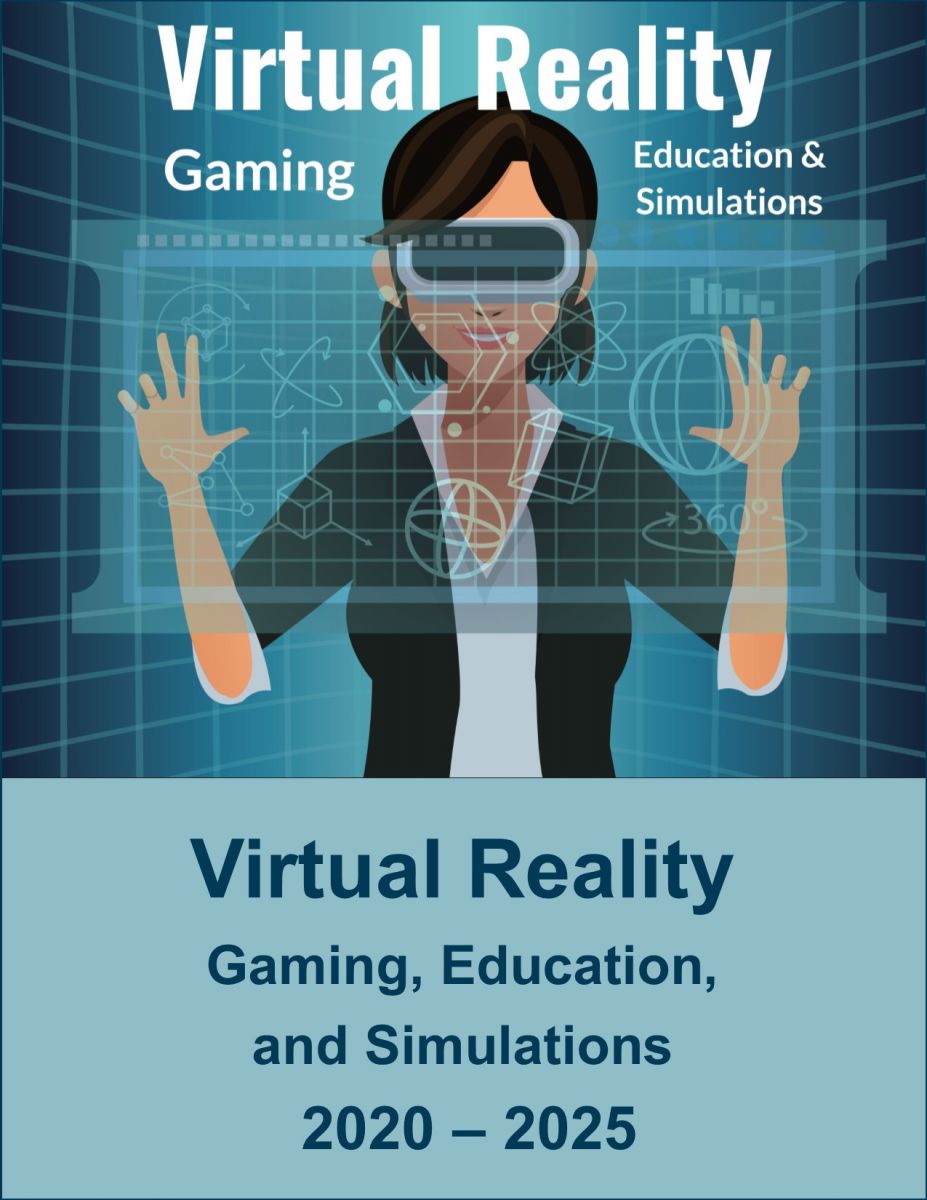Virtual Reality Market in Gaming, Education, and Simulations 2020 – 2025ゲーム、教育、シミュレーションの仮想現実市場 2020-2025年 米国調査会社マインドコマース(Mind Commerce)の調査レポート 「ゲーム、教育、シミュレーションの仮想現実市場 2020-2025年」 は、ゲーム、教育、シミュレーショントレーニングに使用される消費者と企... もっと見る
Summary
Overview This report evaluates VR applications for the consumer and enterprise sectors for which we see gaming, education, and simulations training leading the way. The report assesses leading companies, strategies, products and services. It provides analysis and forecasts for VR gaming, education, and simulations for 2020 through 2025. Mind Commerce sees fully immersive virtual reality systems gaining substantial market momentum in consumer markets within the next few years. These VR systems will provide an unprecedented digital experience for humans, often including multiple senses as well as interaction with virtual objects and/or interaction between the real and virtual worlds. In terms of the consumer segment, Mind Commerce sees current VR gaming evolving from current offerings such as HTC Vive, Oculus Rift, and PlayStation VR to more sophisticated entertainment that involves elements of casual gaming combined with real-world interests involving economy and social status. In many respects, VR gaming is a greenfield opportunity, which will bring many new market entrants into the fray as application and content providers aggressively compete to establish a loyal user base. For example, Skydance Interactive, a division of Skydance Media, has recently unveiled The Walking Dead: Saints & Sinners, initially available on Oculus Rift, Rift S, Quest, and HTC Vive. Successful companies will be those that develop communities of interest based on game-play and follower dynamics including innovation in interactive e-sports entertainment, in-game reward systems, and real-world to VR gamification integration. Long-term success will be dependent upon game delivery platform, system, and connectivity independence. This will occur coincident with a few key trends in platform/network transformation and service delivery such as the shift from console to cloud supported platforms and 5G communications supported by edge computing. Some very compelling enterprise VR applications are anticipated to emerge over the next three to five years. Many of these will be solution-focused upon achieving very specific internal business goals such as risk mitigation, expense reduction, and employee training. For education, we see everything from situational training (such as Verizon using Striver to train its employees how to better deal with robberies) to more traditional expectations such as VR enhanced simulations for flight and vehicle training. We also see enterprise applications extending beyond internal use and B2B as businesses embrace the use of VR to reach consumer markets. Real estate is a prime example where VR may be used for education-sales such as training new home buyers while simultaneously marketing properties. Mind Commerce sees the virtual reality market gaining ground once 5G is more firmly in place commercially, but not entirely due to wireless VR. Instead, we see a massive build-out of broadband as a whole (due to competition from the 5G market) as one of the fundamental drivers for VR adoption. This will be driven in part by substantially greater availability of FTTX and HFC as well as greater bandwidth overall at lower costs. We see 5G acting as a launch pad for enhanced consumer wireless services such as augmented reality, virtual reality, and cloud gaming. Previously encumbered by a combination of technology gaps and consumer readiness issues, virtual reality market is poised for substantive global growth, providing abundant opportunities for service providers, content developers, and ecosystem component providers. While today many apps and services within the XR universe are very device dependent and network constrained, convergence is on the horizon from a device perspective as well as substantial opportunities through untethering via 5G and Mobile Edge Computing (MEC). MEC will be particularly important in support of latency-sensitive apps and services for various consumer, enterprise, and industrial use cases. This will be particularly the case for VR portability, and to some extent, mobility to the extent that there is good 5G coverage. Substantially lower latency facilitated by the combination of 5G and MEC will lead to many new and enhanced applications. For example, VR based telepresence will ultimately become the norm, starting with private enterprise solutions and the SMB markets through the likes of Zoom. Through Voice over 5G (Vo5G), there will also be support for Ultra High Definition (UHD) audio communications, streaming video and ultra-clear voice communication for next generation virtual reality applications and services. Vo5G will benefit VR for consumer and enterprise applications in many respects such as UHD becoming the norm in immersive experiences. Target Audience: · Virtual reality companies · Electronics manufacturers · Network service providers · Regulatory and policy groups · Artificial intelligence providers · Application and content providers Report Benefits: · Analysis and forecasts for VR in gaming, education, and simulations · Understand the VR ecosystem including equipment, platforms, and services · Identify the leading VR vendors, strategies, products, applications, and services · Understand the VR market drivers including economics, adoption, and usage factors Companies in Report: · 3D Systems Simbionix · Analog Devices Inc. · Avegant Corp. · BARCO · Cyber Glove Systems · Cypress Semiconductor Corp · EON Reality Inc. · FOVE Inc. · Google Inc. · HTC Corporation · Huawei Technologies · Integrated Device Technology Inc · Intel Corporation · Leap Motion Inc. · LG Corporation · Magic Leap · Maxim Integrated · Microsoft Corporation · NextVR · NGRAIN Corporation (mCloud) · Niantic Inc. · Nokia · Nvidia Corporation · NXP · Qualcomm Inc. · Rohm Semiconductor · Samsung Electronics Co. Ltd. · Semtech Corporation · Sixense Entertainment Inc. · SK Telecom · Sony Corporation · StreamVR · Texas Instruments · Unity Technologies · VIRTALIS · Virtual Reality Company (VRC) · VREAL · Vuzix Corporation · Wevr · WorldViz · Zeiss VR One · ZTE Corporation Table of Contents
1 Executive Summary
2 Introduction
3 Virtual Reality Ecosystem Analysis
5.0 VR Company Analysis
6.0 Virtual Reality Market in Gaming, Learning, and Simulations 2020 – 2025
ご注文は、お電話またはWEBから承ります。お見積もりの作成もお気軽にご相談ください。本レポートと同分野の最新刊レポート
Mind Commerce社のその他分野での最新刊レポート
本レポートと同じKEY WORD(virtual)の最新刊レポート
よくあるご質問Mind Commerce社はどのような調査会社ですか?マインドコマース(Mind Commerce)は、ネットワークインフラ、Eコマース、オンラインコンテンツ、アプリケーションなど、有線と無線の両方の通信市場を広範かつ詳細に調査・分析を行ったレポートを数... もっと見る 調査レポートの納品までの日数はどの程度ですか?在庫のあるものは速納となりますが、平均的には 3-4日と見て下さい。
注文の手続きはどのようになっていますか?1)お客様からの御問い合わせをいただきます。
お支払方法の方法はどのようになっていますか?納品と同時にデータリソース社よりお客様へ請求書(必要に応じて納品書も)を発送いたします。
データリソース社はどのような会社ですか?当社は、世界各国の主要調査会社・レポート出版社と提携し、世界各国の市場調査レポートや技術動向レポートなどを日本国内の企業・公官庁及び教育研究機関に提供しております。
|
詳細検索
2025/04/15 10:26 144.64 円 164.16 円 193.23 円 |


 米国調査会社マインドコマース(Mind Commerce)の調査レポート
米国調査会社マインドコマース(Mind Commerce)の調査レポート